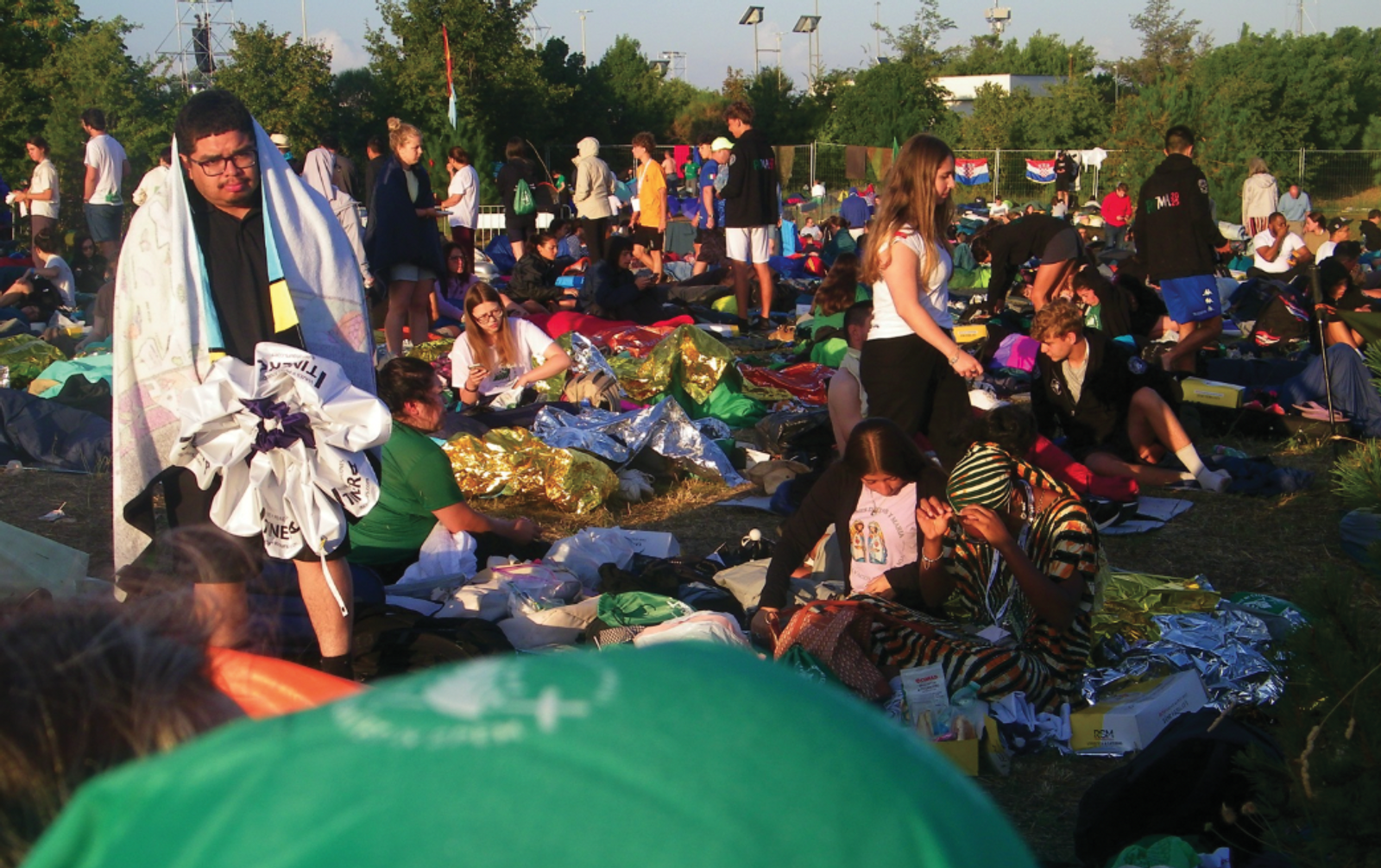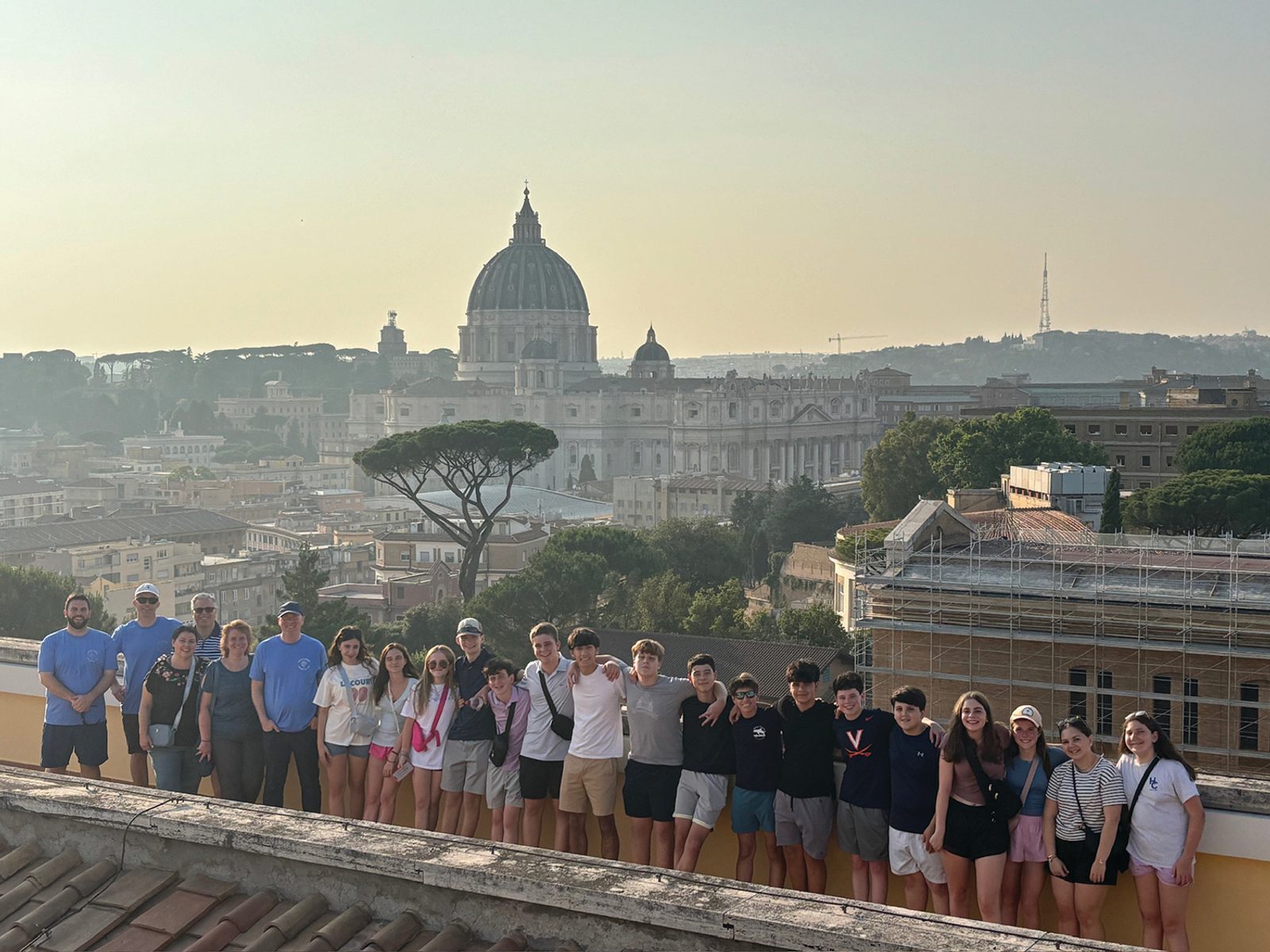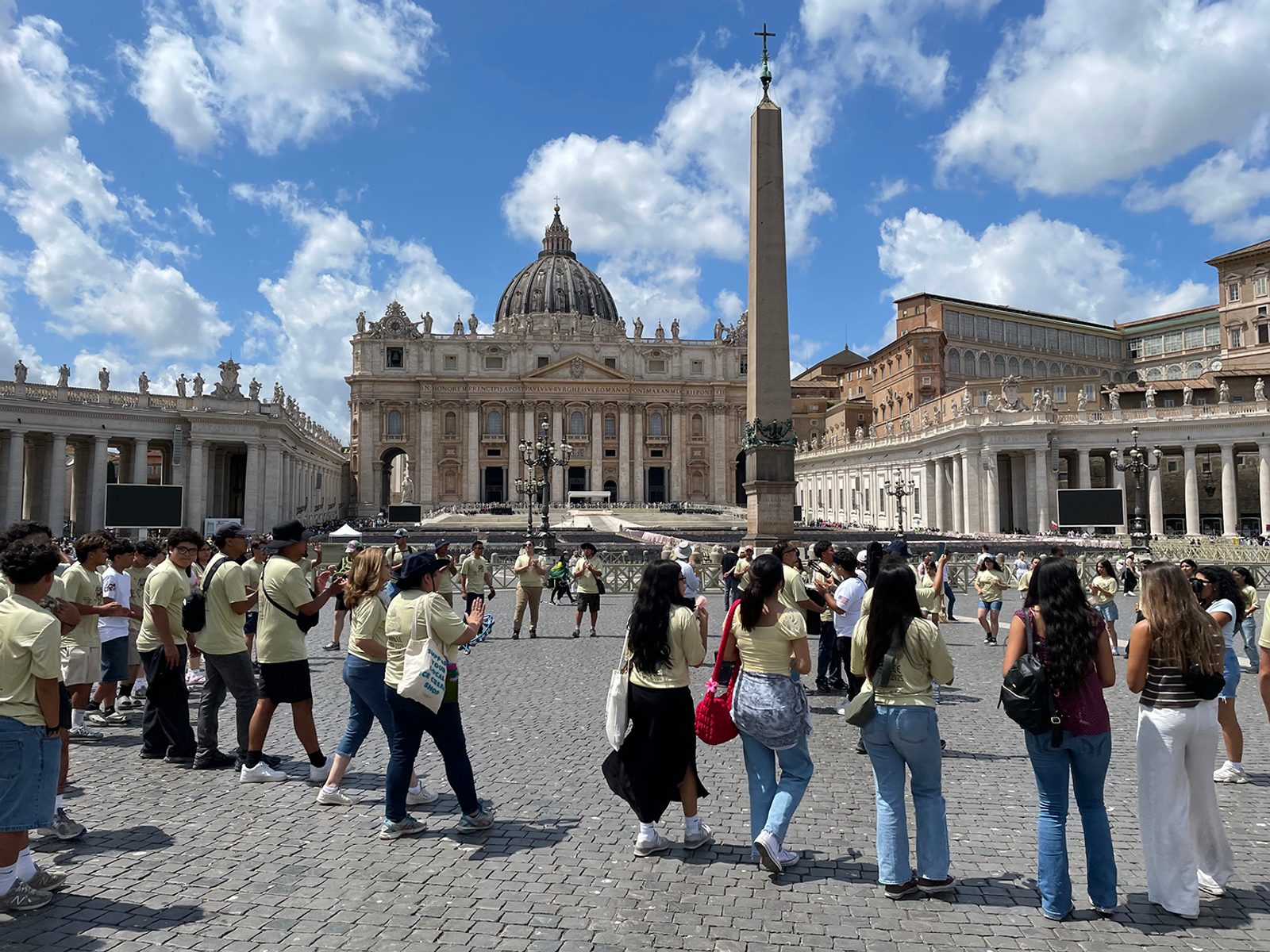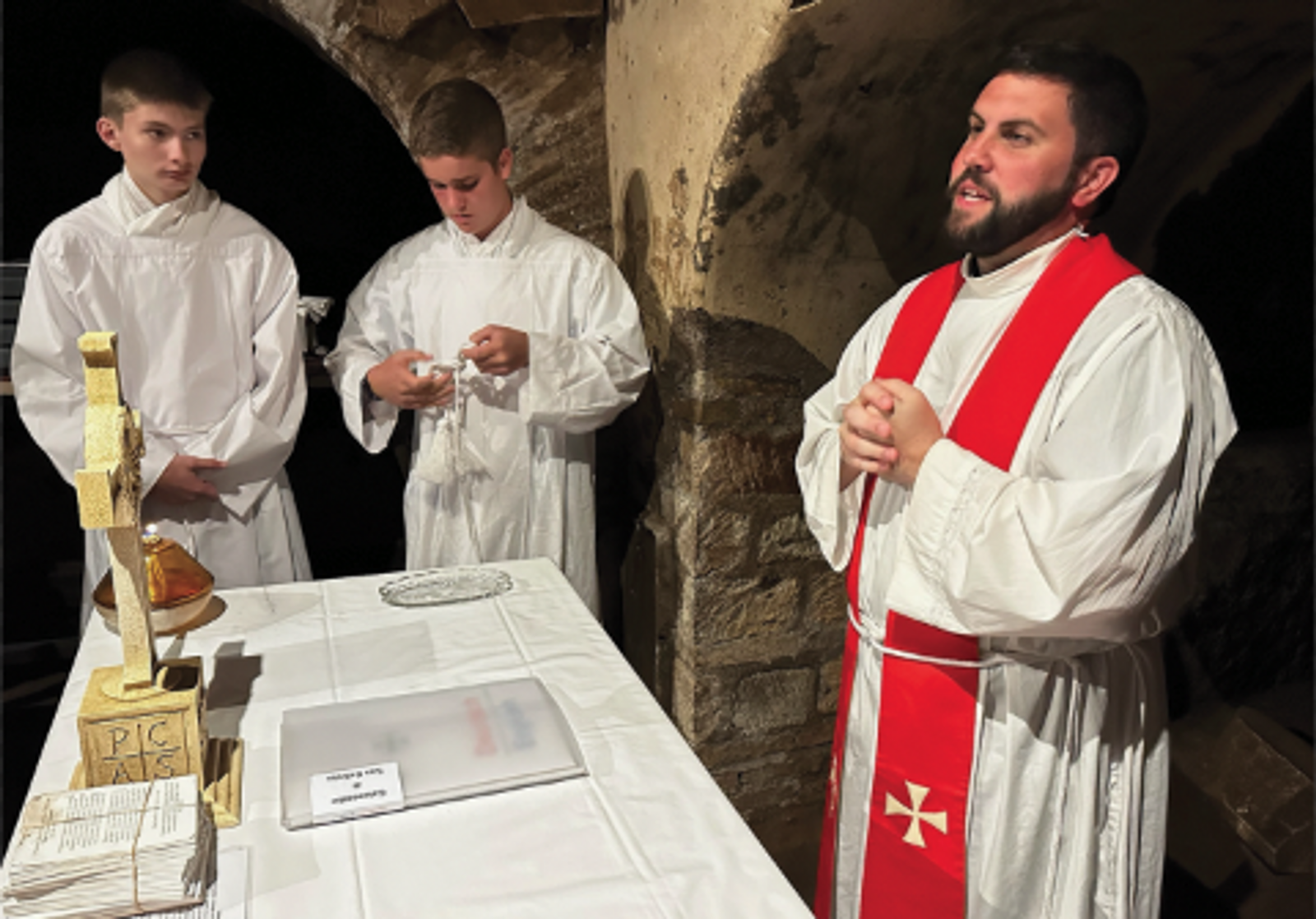In the Jubilee Year of Hope, young people from the Roman Catholic Archdiocese of Washington traveled to Rome on three separate pilgrimages for prayer, fellowship, and encounters with the global Church.
First to travel were parishioners from the Church of the Little Flower in Bethesda, Maryland, who made a June 11–19 pilgrimage under the theme “Hope Does Not Disappoint.” Their journey was a whirlwind of Church history and personal milestones, beginning with Mass at the Basilica of St. Anthony of Padua, where Father Thomas Robertson celebrated his first Mass in Rome. At the time of the pilgrimage, Father Robertson was the parish’s parochial vicar; he now serves as priest secretary to Cardinal Robert W. McElroy, archbishop of Washington.
On their first day in Rome, some Little Flower pilgrims climbed the Scala Santa, or “Holy Stairs” — 28 marble steps believed to be the same ones Jesus ascended to reach Pontius Pilate during his Passion. According to tradition, the steps were brought from Jerusalem to Rome in the fourth century by St. Helena, mother of Emperor Constantine, the first Roman emperor to convert to Christianity. Pilgrims ascend the stairs on their knees, pausing in prayer on each step. From there, the group explored the layered history of the Basilica of St. Clement and was welcomed by seminarians on the roof of the Pontifical North American College.
During their pilgrimage, youth from the Church of the Little Flower carried hundreds of prayer intentions from their parish through every Holy Door they passed. They toured the Colosseum and Roman Forum, prayed at the Basilica of St. Mary Major in the chapel beside the tomb of Pope Francis, and joined the stream of pilgrims carrying the Jubilee Cross through St. Peter’s Square before entering the basilica.
Outside Rome, the group traveled to Assisi to pray at the Basilicas of St. Francis and St. Clare and to visit the resting place of Blessed Carlo Acutis.
Two other groups – the archdiocesan Catholic Youth Organization (CYO) and youth from the Neocatechumenal Way – traveled to Rome for the Jubilee of Hope for Young People. Held July 28 to Aug. 3, the event was a worldwide gathering for people ages 18 to 35 that included prayer, catechesis, and fellowship. Highlights included a special celebration with the Pope, featuring a vigil and Mass at Tor Vergata. The large open-air field on the outskirts of Rome, best known as the site of the record-setting World Youth Day 2000 with St. John Paul II, was chosen for its capacity to host thousands of young pilgrims from around the globe.

During their journey, the CYO pilgrims visited some of Italy’s most notable sacred and historic sites. Highlights included the ancient ruins of Pompeii, the Basilica of the Holy House in Loreto, the Sanctuary of Padre Pio in San Giovanni Rotondo, the Basilica of St. Francis of Assisi, and the Cathedral of Orvieto. The pilgrimage concluded in Vatican City, where they joined thousands of other young people for the Jubilee celebrations.
The Neocatechumenal Way pilgrimage gathered more than 80 youth and their chaperones from across the archdiocese. Led by Father John Benson, pastor of St. John Vianney in Prince Frederick, Maryland, the group visited the Catacombs of St. Callixtus; Tre Fontane where St. Paul was martyred; the Basilicas of St. Peter and St. Paul where they passed through the Jubilee Holy Doors; the basilicas of St. Bernardine of Siena in L’Aquila, St. Joseph Cupertino in Osimo, and of St. Francis and St. Clare in Assisi; and the tomb of Blessed Carlo Acutis.
Witness to Faith: Voices from the Jubilee Pilgrimage to Rome
From the first step onto cobblestone streets to the last prayer before boarding the flight home, the youth pilgrims of the Archdiocese of Washington were immersed in a living encounter with the Church’s heart during their pilgrimages for the Jubilee of Hope.
“Rome is a beautiful city filled with so much architecture and history, but most importantly it is the center of Christianity,” said Little Flower parishioner, Anna-Cecilia Ochoa, who is a sophomore at Georgetown Visitation Preparatory School in Washington, D.C. “The Mass at St. Peter's Basilica with the Pope was something I will never forget.”
For many, the pilgrimage marked both their first trip abroad and their first encounter with Catholicism on a global scale. Favour Obimba, a freshman at Coppin State University in Baltimore, Maryland, and a member of St. Joseph Parish in Largo, Maryland, recalled traveling through eight cities in Italy with the CYO group.
“Each basilica we visited had exquisite artwork, often more than 1,000 years old,” she said. “My favorite was St. Peter’s Basilica because his tomb was there, and he was one of Jesus’s closest friends and followers.”


The daily pace was demanding and included miles of walking in the summer heat, yet pilgrims shared how much joy poured out into the streets by their fellow pilgrims. “In almost every city, there were large groups of people dancing, singing, and playing instruments,” Obimba said. “They waved flags from all over the world. I even jumped in and danced with them.”
For some, quiet prayer marked the heart of the journey. Luke O’Connell, a theology faculty member at Georgetown Visitation Preparatory School who traveled with his daughter Clare, a sophomore at the school, recalled a few of the Little Flower pilgrims giving up an early bedtime to pray a holy hour in a nearly empty St. Peter’s Basilica, lit only by candlelight.
Sister Grace Marie Horan, who is the director of religious education at the Church of the Little Flower and who belongs to the Franciscan Sisters of the Eucharist, (FSE) described the “late-night adoration at St. Peter’s “a key moment for them and for me.”
Brendan Sullivan, a 10th-grader at St. Albans School in Washington, D.C., called the candlelit adoration in St. Peter’s Basilica “a spiritually beautiful moment.” William Carroccio, a sophomore at Gonzaga College High School in Washington, D.C., said it was “an incredible experience,” noting there were “very few of us in the whole church.”
Other Little Flower pilgrims said the trip gave them courage and clarity.
“God is always with you, no matter where you are,” said Charles Gartland, a sophomore at Gonzaga College High School in Washington, D.C.
Clare O’Connell, a sophomore at Georgetown Visitation Preparatory School in Washington, called the experience “incredible and inspiring,” adding, “We truly are part of a global faith.”

Several students spoke about moments of connection with the saints. Vivian Barry, who was part of the Little Flower pilgrimage and is a junior at the Academy of the Holy Cross in Kensington, Maryland, said visiting the tomb of Blessed Carlo Acutis “brought tears to my eyes.”
Father John Benson said one of the most moving moments came at the Basilica of St. Maria Goretti in Nettuno. “Many of the youth had chosen her as a confirmation saint,” he said. “They could see themselves in her story — or in Alessandro’s, or both. Celebrating the Eucharist in the crypt church, looking at her body lying beneath the altar, I think half the group was in tears.”
St. Maria Goretti, an Italian girl canonized in 1950, is remembered for forgiving her attacker, Alessandro Serenelli, before she died from stab wounds at age 11 in 1902. Serenelli later repented and testified to her holiness.
CYO pilgrim, Tiffany Offor, a senior at Elizabeth Seton High School in Bladensburg, Maryland, and member of St. Joseph parish, described visiting Assisi and hearing a talk at the Franciscan Monastery as a spiritual highlight. “It felt so refreshing and new, being surrounded by all those youths from all the corners of the world,” she said.
For Little Flower pilgrim, Tomas Socias, a junior at St. John’s College High School in Washington, D.C., carrying the gifts to Pope Leo during the June 15 Mass at St. Peter’s Basilica for the Solemnity of the Most Holy Trinity — part of the Jubilee of Sport — was “a once-in-a-lifetime experience” that, he said, “changed my life forever and impacted my relationship with God.”
His brother, Jorge Socias Gergoff, a freshman at the same school, said he wanted “to experience Rome not only as a tourist but on the spiritual side, in a city that has been the center of my faith.”
Pierre Fournier Maurisset, a student at Walt Whitman High School in Bethesda, Maryland, said, “I prayed in every single chapel I saw, and the Mass with the Holy Father deepened my faith.”
Leaders on the Little Flower pilgrimage said the journey was far more than sightseeing. Youth minister Linda Kueter explained that the teens were fully engaged, carrying hundreds of parish prayer intentions through each Holy Door and placing them on the altar. Chaperone and CCD volunteer Christian Barry remembered how those intentions traveled with them to every site, and how, on the final day, Father Thomas Robertson read them all aloud — a process that took more than 40 minutes and resonated with the group.
For chaperone Guiomar Barbi Ochoa, walking to St. Peter’s with the Jubilee Cross made the purpose of their pilgrimage tangible, while Manuel Ochoa said witnessing the sites through the eyes of the youth renewed his own faith.

For CYO pilgrim, Beverly Dandridge, who coordinates youth ministry at St. Joseph’s in Largo, the most heartwarming moment was watching her group realize “all the people in Rome for the Jubilee celebration were just like them… young, searching for clarity, and sharing their music and songs in the streets regardless of color, culture, or nation.”
Priests accompanying the youth were equally inspired. Father Tom Robertson, who helped organize the Little Flower pilgrimage, celebrated Mass in historic sites from the Catacombs of St. Callixtus to the tomb of Blessed Carlo Acutis. Marking his third anniversary as a priest during the trip, he said he had “never had a stronger desire to preach the Gospel of Jesus Christ.” At each stop, he encouraged the students to reflect on one question: What are you called to give?
Father John Benson, said youth pilgrimages are when he most tangibly feels his role as a spiritual father.
“I spent twelve days thinking about the physical, emotional and spiritual welfare of our little flock of 80 youth, with no time left over to ponder my own comfort or feelings,” he said. “And because of that, I was very happy.”
He noted that while a pilgrimage can spark profound conversion, the journey does not end when the group returns home. “Some expressed a desire to make concrete changes in their lives — giving up vices, ending harmful relationships. Others felt a call to priesthood, religious life or missionary work. They will need accompaniment to discern and defend that call,” he said.
Father Benson knows the impact firsthand. “I first felt called to the priesthood during a pilgrimage,” he recalled. “I was scared and confused, sure, but I felt an overwhelming desire to give my life to the Lord, whatever that might mean. I am convinced of the efficacy and importance of pilgrimages in the Christian life, especially for young people, to leave behind our many distractions and hear the voice of the Beloved calling us to follow him.”











